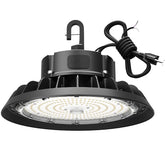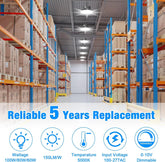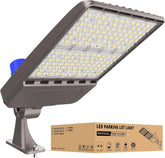Do LED High Bay Lights Get Hot?
When outfitting a warehouse, retail shop, or spacious garage, lighting is a top priority. For many American business owners and homeowners, the question arises: Do LED high bay lights get hot? This concern is valid, especially when safety, energy efficiency, and durability are non-negotiable. LED high bay lighting has surged in popularity across the U.S., from sprawling distribution centers in Texas to cozy auto shops in Michigan. In this article, we’ll dive into how high bay LED lights manage heat, compare them to traditional options, and highlight why they’re a smart choice for various settings. Spoiler alert: LED high bay lights are designed to keep things cool, safe, and cost-effective.
Understanding Heat in LED High Bay Lighting
So, do LED lights get hot? The short answer is: not nearly as much as you might think. Unlike older lighting technologies, high bay LED lights are engineered to produce minimal heat. LEDs (light-emitting diodes) convert most of their energy into light rather than heat, making them inherently cooler. For example, a typical LED high bay fixture might feel warm to the touch after hours of use, but it won’t radiate the intense heat you’d expect from traditional bulbs.
This efficiency stems from the design of LED high bay lighting. Most fixtures include heat sinks—metal components that absorb and dissipate any warmth generated by the diodes. Picture a warehouse manager in Ohio running a 24/7 operation. With LED UFO high bay lights illuminating the space, the fixtures stay cool enough to reduce fire risks and keep the environment comfortable for workers. Data backs this up: LEDs typically operate at temperatures between 77°F and 113°F (25°C to 45°C), far lower than the scorching 200°F+ (93°C+) of metal halide lamps.
Comparing LED High Bay Lights to Traditional Options
To understand why do LEDs get hot is less of a concern, let’s compare high bay LED bulbs to traditional lighting like metal halide or high-pressure sodium lamps, still found in older U.S. facilities. These legacy systems are notorious for generating excessive heat. A 400-watt metal halide bulb can make a warehouse feel like a sauna, driving up air conditioning costs in states like Arizona or Florida. In contrast, a high bay LED light with equivalent brightness—say, 150 watts—produces a fraction of the heat, slashing both energy bills and cooling demands.
For a small business owner in California running a retail shop, this difference is a game-changer. Traditional lights not only heat up the space but also pose safety risks, like overheating fixtures or fading merchandise due to infrared radiation. LED high bay lighting, however, emits virtually no infrared or UV rays, preserving products and keeping customers comfortable. Plus, with lifespans averaging 50,000–100,000 hours, LED high bay fixtures outlast traditional bulbs by years, reducing maintenance headaches for busy facility managers.

Practical Advantages for American Spaces
The low heat output of high bay LED lights translates into tangible benefits across diverse settings. Let’s explore how LED high bay lighting shines for U.S. consumers like warehouse managers, shop owners, and homeowners.
Warehouses and Distribution Centers
In large-scale operations, such as a logistics hub in Georgia, heat management is critical. Forklifts zooming through aisles and workers packing orders need a cool, safe environment. LED UFO high bay lights deliver bright, uniform illumination without turning the space into an oven. Their low heat output reduces strain on HVAC systems, which can save thousands annually on energy costs. For context, the U.S. Department of Energy notes that LED lighting can cut energy use by up to 60% compared to traditional high bay fixtures—a win for any budget-conscious manager.
Retail Shops and Showrooms
For shop owners in cities like Chicago or Denver, ambiance matters. Customers don’t want to browse in a stuffy, overheated store. High bay LED bulbs provide crisp, cool lighting that enhances product displays without fading fabrics or warming up the space. A boutique owner might install LED high bay fixtures to highlight clothing racks, knowing the lights won’t overheat and trigger sprinklers or cause discomfort during peak shopping hours.
Home Garages and Workshops
Homeowners across the U.S., from suburban dads in Pennsylvania to car enthusiasts in Nevada, are upgrading their garages with LED high bay lighting. Why? These lights are perfect for high-ceiling spaces where bright, reliable illumination is a must. Worried about do LED lights get hot when you’re wrenching on a car for hours? With high bay LED lights, you get powerful lighting without the risk of burning your hand on a scalding bulb or worrying about fire hazards near flammable materials like paint cans.

Safety and Reliability Across the Board
Regardless of the setting, low heat output enhances safety. In a Missouri manufacturing plant, for instance, LED high bay fixtures reduce the risk of burns or electrical issues, ensuring compliance with OSHA standards. For homeowners, cooler lights mean peace of mind when kids are playing near garage workbenches. Plus, the durability of high bay LED bulbs means fewer replacements, which is a relief for anyone tired of climbing ladders to swap out burnt-out bulbs.
Why Low Heat Makes LED High Bay Lights a Smart Investment
The benefits of LED high bay lighting extend beyond just staying cool. Here’s why American consumers are making the switch:
- Energy Savings: With less heat waste, high bay LED lights use up to 80% less electricity than metal halide or fluorescent systems. For a Texas warehouse, this could mean hundreds of dollars saved monthly.
- Longevity: Cooler operation extends the life of LED high bay bulbs, reducing downtime and replacement costs. A Minnesota gym owner can enjoy years of maintenance-free lighting.
- Environmental Impact: LEDs are eco-friendly, with no toxic mercury or excessive energy drain. This resonates with sustainability-minded businesses in Oregon or homeowners wanting greener homes.
- Versatility: From LED UFO high bay designs for sleek aesthetics to rugged fixtures for industrial use, there’s an option for every American space.

Addressing Common Concerns
Still wondering, do LEDs get hot enough to cause issues? While high bay LED lights do generate some warmth, it’s negligible compared to alternatives. Proper installation—ensuring adequate ventilation and using quality fixtures—eliminates any concerns. For example, a Florida auto shop owner might pair LED high bay lights with ceiling fans to keep air circulating, though the fixtures themselves add little heat. Reputable brands also undergo rigorous testing to meet UL and DLC standards, ensuring safety and performance.
Another concern is whether low heat affects brightness. Rest assured, high bay LED bulbs deliver lumens that rival or surpass traditional lights. A 100-watt LED high bay can output 14,000–20,000 lumens, perfect for illuminating a Seattle woodworking shop or a New Jersey storage facility.

Stay Cool with LED High Bay Lighting
So, do LED high bay lights get hot? Not in any way that should worry you. Thanks to their efficient design, high bay LED lights keep heat to a minimum while maximizing brightness, safety, and savings. Whether you’re a warehouse manager in Atlanta, a shop owner in San Francisco, or a homeowner in Raleigh with a passion for DIY projects, LED high bay lighting offers a reliable, cost-effective solution tailored to your needs. With lower energy bills, fewer maintenance hassles, and a safer environment, it’s no wonder why Americans are switching to LED high bay fixtures in droves.

Ready to transform your space with cool, efficient lighting? Explore LED high bay lighting solutions today and discover how high bay LED lights can brighten your world without breaking a sweat. Visit trusted retailers or consult our GGJIA lighting expert to find the perfect LED UFO high bay or high bay LED bulbs for your unique American space.








